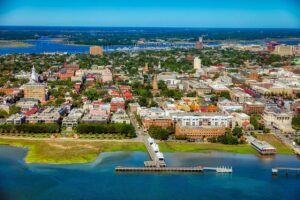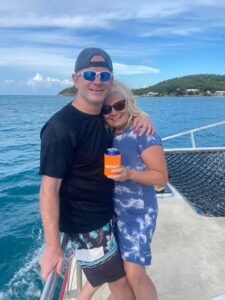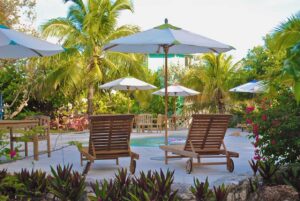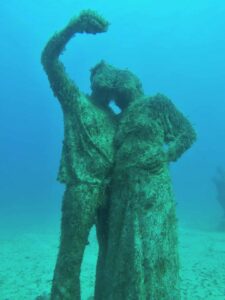We first heard about it years ago on one of those glorious, sun-filled summer days, when a fellow boater shared his dream of one day doing something called the Great Loop. Intrigued by the thought of having an extended adventure aboard our boat without having to battle sea monsters, pirates or gigantic rogue waves on the open ocean, we decided to research the subject. Little did we know that Ron and Eva Stob’s book, Honey, Let’s Get a Boat, would be the kindling for the passion we developed for the cruising lifestyle.
America’s Great Loop Cruisers Association (AGLCA), founded by the Stobs, is dedicated to guiding adventure- seeking boaters along a continuous 6,000-mile waterway journey through the eastern half of the United States and part of Canada. Loopers, the moniker for AGLCA members, cruise the Great Loop in such a manner as to ensure their year long odyssey is spent in warm inviting waters. You’ll find them in Florida during the winter and Canada during the summer. And if things go as planned they’ll always be able to wear shorts!
Our own trip began at the AGLCA Fall Rendezvous event at Joe Wheeler State Park, held every October along the shores of the Tennessee River in northern Alabama. During this four-day rendezvous, seminars are presented to ensure that Loopers are armed with knowledge about the waterways, anchorages, marinas and must-see sites that lie ahead. It’s a perfect time and place to get answers to the myriad questions that plagued all of us before embarking on this adventure of a lifetime.
Leaving Joe Wheeler, we chose to do a side trip up the Tennessee River to Chattanooga before heading down to the Gulf of Mexico. During our four-day journey up the river at the mind-numbing speed of eight miles an hour, we dropped the hook in some of the most picturesque and serene anchorages imaginable. During our weeklong stay in Chattanooga, we tried numerous restaurants, including Maple Street Biscuit Company and Big River Grille & Brewing Works, and none of them ever disappointed. It was very obvious that Chattanooga has spent a great deal of time and the fort making its beautiful, historic waterfront a first-class destination for cruisers.
We then cruised down the Tennessee River to the Tennessee-Tombigbee Waterway at Pickwick Lake, Mississippi. Nicknamed the Tenn-Tom, this 450-mile waterway ends at the Gulf Coast and is actually comprised of two man-made river systems. Some Loopers think of the Tenn-Tom as the quiet segment of the Loop, with the exception of the excitement experienced while descending through Tenn-Tom’s twelve locks.
We stopped in Demopolis, Ala., and while strolling its well-groomed streets we found the sidewalks and yards strewn with pecans from the hundreds of beautiful pecan trees. A nearby antiques shop was nice enough to give us some plastic bags so we could gather up these unclaimed gems. An elderly gentleman who spotted us picking up pecans in front of his neighbor’s house insisted that the pecans from the trees in his yard were much better, and invited us to gather all we could carry! A parishioner came out of the local church and encouraged us to follow her to her backyard because her pecans were “the best in the city.”
Since the 218 miles below Demopolis are void of marinas, anchoring skills are a must. The floating dock along the shoreline at Bobby’s Fish Camp allows visitors the chance to stop and enjoy a fresh cat sh dinner and some genuine rustic charm. The restaurant is only open Thursday through Sunday, but many Loopers have been gratefully surprised when Bobby’s daughter, who lives a half-mile up the road, opens up the restaurant and cooks them a catfish meal with all the trimmings on the off days. Now that’s Southern hospitality!
The view of Mobile’s downtown skyline is a welcome sight after the long journey down the Tenn-Tom. With several boat yards in the area, it’s also an excellent place to get maintenance issues resolved. We docked at Dog River Marina, a full-service facility right at the mouth of the Tenn-Tom. Passing through Orange Beach after leaving Mobile you’ll find marinas loaded with local character and scenic, isolated anchorages. The 250 miles of Intracoastal Waterway (ICW) that traverse the coasts of Alabama and Northwest Florida are the least worrisome sections of the entire ICW system.
Pensacola, Florida, has also gone to great lengths to make its waterfront an attractive cruising destination and there are excellent restaurants downtown. During the tourist off-season, you’ll be able to walk along deserted beaches and watch the sun slowly melt into the Gulf.
After leaving Panama City, the ICW returns to river-like landscapes and placid waters as it continues eastward. Gold Loopers (those who have completed the Loop) know that the charming towns of Port St. Joe, Apalachicola and Carrabelle serve as staging points for the Loop’s greatest challenge: the Gulf Crossing. By now, the cooler air is signaling the arrival of fall’s final days and summoning a southbound change of course. Only a twenty-hour boat ride to Tarpon Springs separates you from temperatures that make it possible to continue wearing shorts!
I always try to remind Loopers that their “job” while on the Loop is to simply enjoy the journey. We made the mistake of planning to share anksgiving dinner with friends in Tarpon Springs. The stress of this commitment made us determined to cross the Gulf by mid-November. Gold Loopers preach to the neophytes that the most dangerous thing to have on the Loop is a schedule. However, we did have a wonderful Thanksgiving in Tarpon Springs and a marvelous Christmas in neighboring Dunedin.





